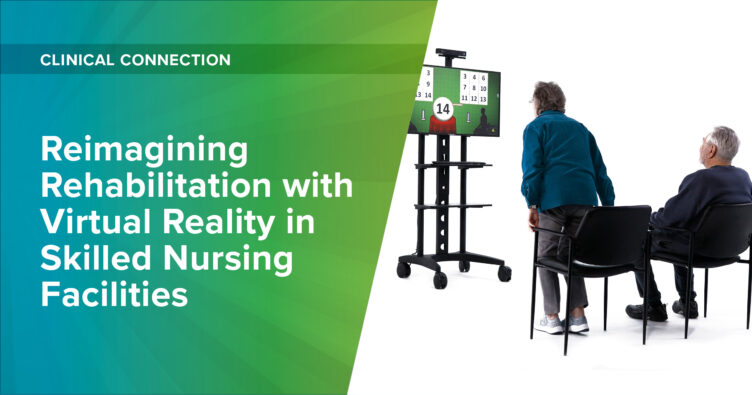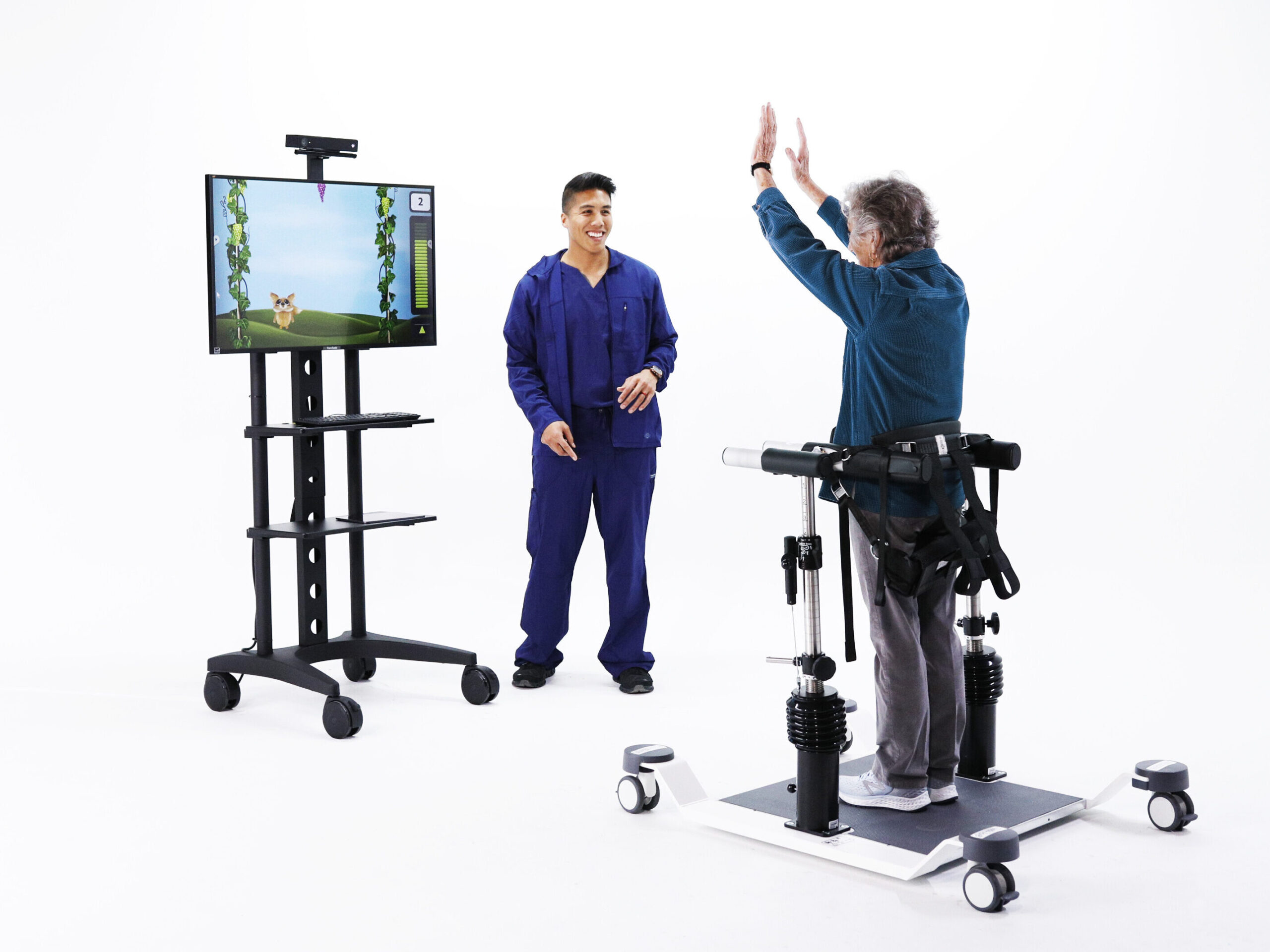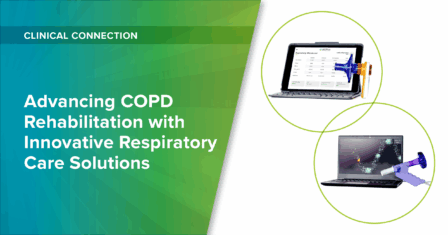Reimagining Rehabilitation with Virtual Reality in Skilled Nursing Facilities

The highlights:
- Virtual reality (VR) has been shown to boost patient motivation and engagement with their treatment.
- VR can push patients to train longer, harder, and with greater intensity, leading to better rehabilitation outcomes.
- By allowing clinicians to maximize their skilled time and incorporate dual-task training, VR can optimize treatment efficiency and effectiveness.
Virtual reality (VR) is revolutionizing rehabilitation in skilled nursing facilities (SNFs), offering innovative solutions to common clinical challenges. As the evidence supporting VR in skilled rehab grows, it’s clear that this technology can reshape patient care and outcomes. Let’s dive into how incorporating VR into therapy has the potential to transform rehab in the SNF space.
The Growing Evidence for VR in Skilled Nursing
VR has been studied for a variety of diagnoses, including stroke1, Parkinson’s disease2, multiple sclerosis3, dementia4, and pain5. Over the years, research has consistently shown VR’s potential to enhance patient engagement and motivation while increasing the repetitions and duration of exercise—critical factors in successful rehabilitative outcomes.
Key Benefits of VR in SNF Settings
Enhancing Patient Engagement
One of the more challenging aspects of skilled nursing rehab is keeping patients engaged and motivated6 to participate in treatment. The immersive nature of VR creates a welcome distraction for many patients, allowing them to push their limits while experiencing something new, exciting, and even fun.
Motivating Longer, More Effective Sessions
In addition to boosting patient engagement, incorporating VR into therapy sessions has also shown a remarkable ability to motivate patients to train longer, harder, and at a greater intensity. This is a recipe for maximizing therapeutic benefits and accelerating recovery.
Improving Mood
Beyond the physical benefits, VR can positively impact patients’ overall well-being. There is evidence that patients who use VR experience mood improvements and reductions in apathy7. Improved mood resulting from VR experiences can significantly influence engagement and recovery, addressing both physical and emotional aspects of healing.
Optimizing Therapy Efficiency and Effectiveness

Dual-Task Training
VR offers an excellent opportunity to introduce dual-task training, where patients work on one activity while simultaneously engaging in other tasks (cognitive or motor). This approach has been shown to be beneficial for postural control, mobility, and cognitive functions88.
Maximizing Skilled Time
For clinicians, VR offers a clinically effective means to maximize patients’ therapy sessions. Therapists can focus on modifying patient parameters to optimize each individual’s exercises, ensuring every minute of therapy is as productive as possible.
Embracing the Future of Skilled Rehabilitation
There is no question that, when used thoughtfully, virtual reality is making a positive impact on patient outcomes. By embracing the potential of VR, skilled nursing facilities can offer more engaging, effective, and efficient therapy programs that reimagine the entire rehabilitation experience.
Reimagine Your Rehab Program
Explore Accelerated Care Plus’ innovative OmniVR technology and subscribe to our blog to be the first to know about future developments in the VR space.
- Karamians, R., Proffitt, R., Kline, D., Gauthier, L.V. (2019, Dec 7). Effectiveness of virtual reality – and gaming-based interventions for upper extremity rehabilitation post-stroke: A meta-analysis. Archives of Physical Medicine and Rehabilitation, (Epub ahead of print), DOI: 10.1016/j.apmr.2019.10.195 ↩︎
- Triegaardt, J., Han, T. S., Sada, C., Sharma, S., Sharma, P. (2019). The role of virtual reality on outcomes in rehabilitation of Parkinson’s disease: Meta-Analysis and systematic review in 1031 Participants. Neurological Sciences, (Epub ahead of print). DOI: 10.10007/s10072-019-04144-3 ↩︎
- Porras, D. C., Siemonsma, P., Inzelberg, R., Zeilig, G., Plotnik, M. (2019). Advantages of virtual reality in the rehabilitation of balance and gait: Systematic review. Neurology, 90(22), 1017-1025. DOI: 10.1212 WNL.0000000000005603 ↩︎
- Coyle, H., Traynor, V., Solowij, N. (2015). Computerized and virtual reality cognitive training for individuals at high risk of cognitive decline: Systematic review of the literature. American Journal of Geriatric Psychiatry, 23(4), 335-359. DOI: 10.1016/j.jagp.2014.04.009 ↩︎
- Mallari, B., Spaeth, E. K., Goh, H., Boyd, B. S. (2019). Virtual reality as an analgesic for acute and chronic pain in adults: A systematic review and meta-analysis. Journal of Pain Research, 12, 2053-2085. DOI 10.2147/JPR.S200498 ↩︎
- Kizmaz, E., Telli Atalay, O., Çetin, N., & Uğurlu, E. (2024). Virtual reality for COPD exacerbation: A randomized controlled trial. Respiratory Medicine, 230, 107696. https://doi.org/10.1016/j.rmed.2024.107696 ↩︎
- D’Cunha, N. M., Nguyen, D., Naumovski, N., McKune, A. J., Kellett, J., Georgousopoulou, E. N., Frost, J., & Isbel, S. (2019). A mini-review of virtual reality-based interventions to promote well-being for people living with dementia and mild cognitive impairment. Gerontology, 65(4), 430-440. DOI: 10.1159/000500040 ↩︎
- Scarmagnan, G. S., Lino, T. B., Pimentel, D.E., Silva, A. V. B., da Silva Ramos, I. M., Christofoletti, G. (2024). Benefits of a dual-task training on motor and cognitive functions in community-dwelling older adults. American Journal of Physical Medicine & Rehabilitation, 103(5), 377-383. DOI: 10.1097/PHM.0000000000002352 ↩︎
MRK-BLOG-009
Virtual reality (VR) is revolutionizing rehabilitation in skilled nursing facilities (SNFs), offering innovative solutions to common clinical challenges. As the evidence supporting VR in skilled rehab grows, it’s clear that this technology can reshape patient care and outcomes. Check out our latest blog to find out how incorporating VR into therapy has the potential to transform rehab in the SNF space.
Latest Updates
Subscribe to stay up-to-date on our latest posts.



